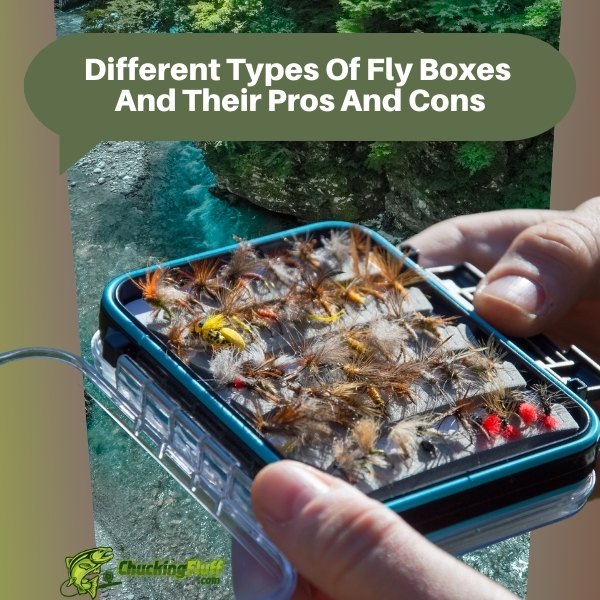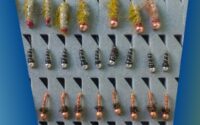| Disclosure: Just to be open and honest the buttons and links you click on in the website will in most cases take you to another website where you can purchase the products I am reviewing. As an Amazon Associate I earn from qualifying purchases. |
Different Types Of Fly Boxes And Their Pros And Cons
Quick Post Navigation
When it comes to fly fishing, there’s an incredible variety of gear that can make or break your fishing experience. Among these essentials is the humble yet crucial fly box. You’ve probably seen the myriad of boxes available in every shape, size, and material, and it may have you wondering: what makes one better than another? Fly boxes are more than just containers; they’re protectors, organizers, and companions for every fly you’ve meticulously tied or bought. This article dives deep into the various types of fly boxes, their strengths, and their shortcomings so you can pick the best one for your needs.
Why Choosing the Right Fly Box Matters
A fly box’s job is pretty straightforward: it holds flies. But it’s not as simple as tossing them into a container. Flies are delicate, and an improperly chosen box can lead to smashed hackles, rusted hooks, and an all-around mess. The right box keeps your flies intact, accessible, and organized, whether you’re fishing on a riverbank, wading waist-deep, or casting from a boat.
Key Factors to Consider When Choosing a Fly Box
When choosing a fly box, certain factors can help narrow down your options.
Durability
Fishing can be hard on gear. A fly box should withstand impact, resist wear, and ideally be rustproof. Think of it like choosing a reliable car—durability is key.
Waterproofing
Water and flies don’t mix well, especially if you want them to last. A waterproof fly box is essential for keeping moisture out and preserving the integrity of your flies.
Capacity and Organization
Are you carrying a handful of favorites or a whole arsenal? Look at the box’s layout and see if it can handle your fly collection without crowding or damage.
Portability
A bulky fly box can be a nuisance on the water. Look for one that’s easy to carry yet big enough to hold what you need.
Common Types of Fly Boxes
Let’s break down the most popular types of fly boxes and weigh their pros and cons.
Compartment Fly Boxes
Compartment fly boxes are divided into small sections, each holding one or more flies. They’re great for organizing different types of flies without them getting tangled.
Pros of Compartment Fly Boxes
- Easy organization for various fly types
- Reduces tangling of hooks
- Clear lids for quick fly identification
Cons of Compartment Fly Boxes
- Limited capacity compared to foam or magnetic boxes
- Can be bulky and less portable
- May allow flies to move around and get damaged
Slit Foam Fly Boxes
Slit foam boxes feature rows of foam with slits to secure flies by their hooks. They’re popular for their compactness and ability to hold flies snugly.
Pros of Slit Foam Fly Boxes
- Holds flies securely without moving around
- Compact design fits easily into vests or packs
- High capacity for its size
Cons of Slit Foam Fly Boxes
- Foam can wear out over time
- Limited to specific hook sizes
- Less ideal for very large or very small flies
Magnetic Fly Boxes
Magnetic fly boxes use magnets to hold flies in place, offering a unique, flexible solution for organizing smaller flies.
Pros of Magnetic Fly Boxes
- Lightweight and slim, ideal for small flies
- Easy to use without messing with foam or slits
- Great for quick fly changes
Cons of Magnetic Fly Boxes
- Not suitable for larger flies or streamers
- Limited capacity
- Can be challenging in windy conditions
Swing-Leaf Fly Boxes
Swing-leaf boxes have a multi-layered structure with swinging “leaves” or dividers, maximizing capacity in a compact space.
Pros of Swing-Leaf Fly Boxes
- Maximizes storage capacity
- Ideal for carrying a wide variety of flies
- Compact and portable
Cons of Swing-Leaf Fly Boxes
- More prone to damage with heavy use
- Can be bulky with multiple layers
- Not always waterproof
Double-Sided Fly Boxes
Double-sided fly boxes offer two compartments, allowing for twice the storage in a single box.
Pros of Double-Sided Fly Boxes
- High storage capacity
- Keeps flies separate for easy organization
- Compact for carrying a wide variety
Cons of Double-Sided Fly Boxes
- Heavier than single-sided options
- May lack waterproofing on both sides
- Harder to quickly access flies
Micro Fly Boxes
Micro fly boxes are tiny and highly portable, making them ideal for minimalists or quick outings.
Pros of Micro Fly Boxes
- Extremely portable and lightweight
- Great for short trips or carrying essential flies
- Easily fits into pockets
Cons of Micro Fly Boxes
- Limited storage capacity
- Not ideal for larger flies
- Easy to misplace due to small size
Specialty Fly Boxes
For those who favor certain types of flies, specialty fly boxes can be a lifesaver.
Streamer Fly Boxes
Streamer fly boxes are tailored for large flies, often with foam or hooks to keep bigger hooks and bodies in place.
Pros of Streamer Fly Boxes
- Holds large flies securely
- Protects streamers from damage
- Usually spacious for bigger flies
Cons of Streamer Fly Boxes
- Bulky compared to other boxes
- Limited versatility for other fly types
- Heavier and harder to carry
Dry Fly Boxes
Dry fly boxes prioritize keeping delicate flies from getting squashed, often using a dome shape or spacious compartments.
Pros of Dry Fly Boxes
- Protects fragile dry flies from damage
- Prevents overcrowding
- Usually waterproof for added protection
Cons of Dry Fly Boxes
- Limited versatility
- Can be bulky
- Often pricier than standard boxes
Innovative and High-Tech Fly Boxes
Some fly boxes come with modern features to enhance the fishing experience.
LED-Lit Fly Boxes
LED-lit boxes illuminate the interior, making it easy to pick out flies in low-light conditions.
Pros of LED-Lit Fly Boxes
- Helpful for night fishing or early mornings
- Adds visibility and convenience
- Usually water-resistant
Cons of LED-Lit Fly Boxes
- Requires batteries or charging
- Heavier and bulkier than regular boxes
- May be unnecessary for daytime fishing
Floating Fly Boxes
Floating fly boxes are designed to float if dropped in water, ideal for clumsy or cautious anglers.
Pros of Floating Fly Boxes
- Adds peace of mind when fishing from boats or wading
- Often brightly colored for easy spotting
- Lightweight and portable
Cons of Floating Fly Boxes
- May not be as durable as other types
- Typically limited in storage capacity
- Can be pricier than non-floating options
Conclusion
Selecting the right fly box is all about finding a balance between storage, protection, and ease of use. Whether you’re a minimalist who just needs the basics or a tackle-heavy angler with a fly for every occasion, there’s a box to match. Consider your fly size, fishing environment, and personal preferences to choose a fly box that will keep your flies organized and ready to use.
FAQs
1. What is the best fly box for beginners?
For beginners, a slit foam fly box is a great choice because it’s compact, affordable, and can hold a variety of flies securely.
2. Are waterproof fly boxes necessary?
While not essential, waterproof boxes are recommended to keep your flies from rusting and degrading, especially if you fish in wet conditions often.
3. Can I use a single fly box for all fly types?
Yes, but some fly types require specific boxes for better protection. Dry flies, for instance, benefit from dry fly boxes that prevent damage.
4. How do I maintain my fly box?
To maintain a fly box, ensure it’s dry before storing, clean out old flies periodically, and avoid overstuffing, which can cause damage to both the box and flies.
5. What size fly box should I choose?
Choose a size based on your fly collection and portability needs. For extensive collections, larger or double-sided boxes work well; for minimal setups, opt for a micro box.



